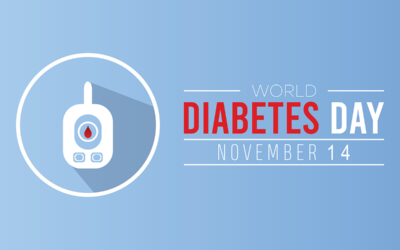World Pancreatic Cancer Day 2025: Turning Awareness into Lifesaving Action

Among all cancer types, pancreatic cancer is one of the most challenging to detect and treat, as it typically shows symptoms in advanced stages. According to the World Health Organization, it is the 6th most common cause of cancer-related death, accounting for almost 470,000 deaths in 2022. In India too, the number of people affected by pancreatic cancer is increasing, yet awareness about its early signs and risk factors remains limited.
World Pancreatic Cancer Day is observed every November to serve as a global reminder of the need for awareness, research, timely diagnosis, and access to treatment. In this article, we will explore pancreatic cancer in detail along with its symptoms, causes, and stages, while highlighting the importance of awareness, prevention, and early diagnosis. But first, let’s learn about the significance of World Pancreatic Day.
Table of Contents
ToggleWhat is World Pancreatic Cancer Day and Why it Matters
World Pancreatic Cancer Day is observed every year on the third Thursday of November (20th Nov 2025) to raise global awareness about one of the deadliest yet least understood forms of cancer. The day serves as a powerful reminder of the need for early detection, improved research, and stronger support for those living with pancreatic cancer.
The first World Pancreatic Cancer Day was launched in 2014 by the World Pancreatic Cancer Coalition, a collective of more than 100 organisations from around the world working together to improve survival rates and quality of life for patients. Since then, the observance has evolved into a global movement that encourages people to “turn the world purple”, the official colour representing pancreatic cancer awareness, and spread knowledge about its early warning signs.
In India, hospitals, cancer care organisations, and medical institutions participate through awareness drives, screening camps, and educational initiatives. These efforts play a crucial role in breaking myths, improving understanding, and motivating people to seek timely medical care.
Together, these initiatives emphasise one essential message: early diagnosis saves lives.
What is Pancreatic Cancer?
Pancreatic cancer begins in the tissues of the pancreas, a vital organ located behind the stomach that helps regulate blood sugar and aids digestion by producing essential enzymes and hormones. When abnormal cells in the pancreas grow uncontrollably, they form a tumour that can interfere with normal pancreatic functions and spread to nearby organs.
This condition is often difficult to detect in its early stages because the pancreas is located deep within the abdomen, and symptoms may not appear until the cancer has progressed. As a result, pancreatic cancer is sometimes referred to as a “silent disease”, highlighting the importance of awareness, regular check-ups, and early medical evaluation.
Pancreatic cancer can affect both men and women, most commonly in individuals over the age of 50. However, factors such as family history, smoking, chronic pancreatitis, obesity, and uncontrolled diabetes may increase the risk at an earlier age.
Types of Pancreatic Cancer
Pancreatic cancers are primarily divided into two categories based on the type of cells involved:
- Exocrine Tumours: These begin in the pancreatic ducts and account for over 90% of cases. The most common type is pancreatic ductal adenocarcinoma.
- Endocrine (neuroendocrine) Tumours: These form in the hormone-producing cells of the pancreas and are less common but tend to grow more slowly.
Symptoms of Pancreatic Cancer
Pancreatic cancer often develops quietly, showing little to no symptoms in its early stages. When signs do appear, they are often vague and mistaken for other metabolic or digestive problems. Recognising these subtle changes early can make a significant difference in timely diagnosis and treatment.
Common symptoms of pancreatic cancer may include:
- Persistent abdominal pain: Often felt in the upper abdomen and sometimes radiating to the back.
- Unexplained weight loss: A sudden, unintended drop in weight without major lifestyle changes.
- Jaundice: Yellowing of the skin and eyes caused by blockage of the bile duct.
- Loss of appetite and nausea: Reduced desire to eat and discomfort after meals.
- Changes in stool colour: Pale, greasy, or floating stools may indicate poor fat digestion.
- Dark urine: Caused by high bilirubin levels in the blood.
- Fatigue and weakness: A result of the body’s reduced ability to process nutrients.
- New-onset diabetes: In some cases, pancreatic cancer can cause sudden changes in blood sugar levels.
While these symptoms can be linked to other conditions, persistent or worsening signs should never be ignored. Early medical evaluation offers the best chance for effective management and recovery.
Read More: Cancer is Curable if Detected in Early Stage
Causes of Pancreatic Cancer
The exact cause of pancreatic cancer is not fully understood, but research suggests that it develops from a combination of genetic, lifestyle, and environmental factors. These factors can either trigger abnormal cell growth in the pancreas or increase a person’s susceptibility to the disease over time. Common causes of pancreatic cancer include:
- Genetic mutations: Inherited gene changes such as BRCA2 or Lynch syndrome can raise the risk.
- Chronic pancreatitis: Long-term inflammation of the pancreas can damage tissues and increase cancer risk.
- Diabetes: Long-standing or new-onset diabetes is often linked with higher pancreatic cancer risk.
- Smoking: Cigarette smoking is one of the strongest preventable risk factors.
- Obesity: Excess body fat can cause hormonal imbalances that encourage cancer growth.
- High-fat diet: Regular intake of processed and fatty foods may contribute to risk over time.
- Age and gender: The condition most often affects people over 50 and is slightly more common in men.
High-Risk Groups
Individuals with a family history of pancreatic or gastrointestinal cancers, genetic syndromes, or previous abdominal radiation exposure may be more vulnerable. Regular health check-ups and genetic counselling are recommended for those in these categories.
When to See a Doctor?
Because pancreatic cancer often progresses silently, knowing when to seek medical attention can make a life-saving difference. Early symptoms are subtle and may resemble common digestive problems, but persistent or worsening signs should never be ignored. Consulting a doctor promptly allows for timely diagnosis and effective management.
Individuals should see a specialist if they experience:
- Persistent abdominal pain that radiates to the back or worsens after meals.
- Unexplained weight loss despite a normal diet.
- Yellowing of the skin and eyes (jaundice) without a known liver condition.
- Loss of appetite, nausea, or frequent indigestion.
- Changes in stool or urine colour, such as pale stools or dark urine.
- Sudden onset of diabetes or fluctuations in blood sugar levels.
- Family history of pancreatic or gastrointestinal cancers.
Early consultation with a gastroenterologist or oncologist can help identify pancreatic abnormalities through imaging or blood tests before the condition advances.
Pancreatic Cancer Screening and Diagnosis
Early detection of pancreatic cancer is challenging due to the lack of noticeable symptoms in its initial stages. However, modern diagnostic tools have significantly improved the chances of identifying the condition early, allowing for timely and more effective treatment. Common screening and diagnostic tests include:
- Blood tests: Measurement of tumour markers such as CA 19-9 may help identify abnormal activity in the pancreas.
- Ultrasound (abdominal or endoscopic): Ultrasound helps detect masses or blockages in and around the pancreas.
- CT or MRI scans: CT scans or MRI scans provide detailed cross-sectional images to determine tumour size, spread, and location.
- Endoscopic Ultrasound (EUS): Combines endoscopy and ultrasound to obtain high-resolution images of the pancreas.
- Biopsy: Biopsy involves extracting a small tissue sample for laboratory analysis to confirm cancer diagnosis.
- ERCP (Endoscopic Retrograde Cholangiopancreatography): Used to check bile and pancreatic ducts for obstructions or growths.
Stages of Pancreatic Cancer
The disease is generally classified into four main stages based on the tumour’s size, location, and whether it has spread to nearby tissues or distant organs. Different stages of pancreatic cancer include:
- Stage I: The tumour is confined to the pancreas and may be removed surgically.
- Stage II: Cancer has spread to nearby tissues or lymph nodes but remains localised enough for potential surgery.
- Stage III: The tumour has grown into nearby major blood vessels, making surgical removal more complex or sometimes not possible.
- Stage IV: The cancer has spread (metastasised) to distant organs such as the liver or lungs. Treatment focuses on controlling symptoms and slowing disease progression.
Identifying the accurate stage of the cancer is crucial for designing a personalised treatment plan.
Treatment Options for Pancreatic Cancer
Treatment for pancreatic cancer depends on the stage of the disease, overall health of the patient, and whether the tumour can be surgically removed. Common treatment options include:
1. Surgery
Surgical removal of the tumouroffers the best chance for long-term survival, especially when the cancer is detected early. Common procedures include:
- Whipple procedure (pancreaticoduodenectomy): The Whipple procedure (pancreaticoduodenectomy) removes the head of the pancreas along with nearby tissues.
- Distal pancreatectomy: Removes the body and tail of the pancreas.
- Total pancreatectomy: Performed in advanced cases where the entire pancreas must be removed.
2. Chemotherapy
Chemotherapy uses powerful drugs to destroy cancer cells or prevent their growth. It may be given before surgery (neoadjuvant therapy) to shrink the tumour or after surgery (adjuvant therapy) to prevent recurrence.
3. Radiation Therapy
High-energy beams target cancerous cells to reduce tumour size or ease symptoms such as pain or digestive discomfort. It is often combined with chemotherapy for better results.
4. Targeted and Immunotherapy
These advanced treatments focus on specific cancer cell mutations or boost the body’s immune response. They are particularly useful for patients with genetic variations like BRCA mutations or metastatic cancer.
5. Supportive and Palliative Care
In later stages, the focus shifts to symptom management, pain control, and improving quality of life through nutritional support, counselling, and physiotherapy.
Multidisciplinary care, involving oncologists, surgeons, radiologists, dietitians, and mental health professionals, ensures that every patient receives comprehensive and compassionate treatment tailored to their condition.
How Pancreatic Cancer Affects a Person’s Life
Understanding the broader impact of pancreatic cancer helps highlight why awareness, early diagnosis, and holistic care are so essential. The condition affects more than just physical health – it can influence emotional stability, daily living, and overall well-being.
Physical Impact
The pancreas plays a vital role in digestion and blood sugar regulation, so pancreatic cancer can disrupt many of the body’s essential functions. Patients may experience:
- Fatigue and weakness due to poor nutrient absorption.
- Abdominal pain or back discomfort caused by tumour pressure.
- Loss of appetite and unexplained weight loss.
- Changes in blood sugar levels leading to diabetes or instability.
Emotional and Psychological Impact
A diagnosis of pancreatic cancer often brings emotional distress. Feelings of anxiety, fear, or uncertainty about treatment and recovery are common. Counselling, mental health support, and patient groups can help individuals and their families cope more effectively during this time.
Social and Lifestyle Impact
The disease can affect work, family interactions, and financial stability. Frequent medical visits and treatment sessions may also disrupt daily routines. Strong family involvement and social support play a crucial role in ensuring emotional resilience and continuity of care.
By addressing the physical, emotional, and social aspects of pancreatic cancer, patients can achieve a better quality of life and a more positive outlook during their treatment journey.
How to Prevent Pancreatic Cancer
While not all cases of pancreatic cancer can be prevented, several lifestyle and dietary choices can significantly reduce the risk. Awareness about modifiable risk factors, coupled with timely health check-ups, plays an important role in prevention, especially for those with a family history or existing medical conditions such as diabetes or pancreatitis. Here are some key preventive measures that can help lower the risk of developing pancreatic cancer:
1. Maintain a Healthy Diet
A balanced diet rich in fruits, vegetables, whole grains, and foods high in dietary fibre supports pancreatic health. Limiting processed meats, refined sugars, and high-fat foods can help lower the risk of pancreatic and other gastrointestinal cancers.
2. Quit Smoking and Limit Alcohol Consumption
Smoking is a leading preventable cause of pancreatic cancer. Avoiding tobacco and limiting alcohol consumption reduce inflammation and protect pancreatic tissues from damage.
3. Exercise Regularly and Maintain a Healthy Weight
Obesity is closely linked to an increased risk of pancreatic cancer. Regular physical activity and maintaining a healthy weight help regulate hormones and insulin levels, reducing stress on the pancreas.
4. Control Diabetes and Pancreatitis
Monitoring blood sugar levels and following medical advice for diabetes or chronic pancreatitis helps reduce long-term pancreatic stress.
5. Regular Screening for High-Risk Individuals
Those with a family history of pancreatic cancer or genetic syndromes should consider periodic screening and genetic counselling. Early detection of any abnormalities can make treatment more effective.
Making small but consistent lifestyle adjustments and staying aware of body changes can go a long way in preventing pancreatic cancer and ensuring long-term health.
Why Choose Graphic Era Hospital for Pancreatic Cancer Care
At Graphic Era Hospital, Dehradun, pancreatic cancer care is guided by precision, compassion, and multidisciplinary expertise. The hospital combines advanced technology with patient-focused treatment plans to ensure that every individual receives comprehensive and personalised care from diagnosis through recovery. Our comprehensive pancreatic cancer care include:
Experienced Oncologists and Gastroenterologists
A team of skilled oncologists, gastroenterologists, and surgeons work collaboratively to diagnose and treat pancreatic cancer using the latest evidence-based approaches. Their experience in managing complex and advanced-stage cases ensures each patient receives the most appropriate treatment plan.
Advanced Diagnostic and Surgical Technology
The hospital is equipped with cutting-edge imaging systems, endoscopic facilities, and minimally invasive surgical facilities and tools that enhance diagnostic accuracy and treatment precision. This technology allows for faster recovery, reduced complications, and better quality of life post-treatment.
Personalised and Patient-Centred Care
Graphic Era Hospital prioritises holistic care, addressing not just the medical but also the emotional and nutritional needs of patients. From counselling and dietary guidance to physiotherapyand post-surgical rehabilitation, every step is designed to support comfort and healing.
Comprehensive Rehabilitation and Follow-Up
Patients benefit from continuous monitoring and rehabilitation programmes aimed at restoring strength and well-being after treatment. Regular follow-ups help detect any recurrence early and ensure long-term health management.
How You Can Contribute to Pancreatic Cancer Awareness
Raising awareness about pancreatic cancer is not limited to healthcare professionals – every individual can play a part in promoting early detection and supporting those affected. Small, collective actions can make a lasting impact on communities and help save lives.
Here are a few meaningful ways to contribute:
- Participate in awareness campaigns: Join local or online events on World Pancreatic Cancer Day to spread knowledge about symptoms, risk factors, and the importance of early diagnosis.
- Wear purple: Purple is the official colour of pancreatic cancer awareness. Wearing it on the day symbolises solidarity and support for patients and survivors.
- Share verified information: Use social media platforms to share trusted facts about pancreatic cancer and encourage timely medical consultation for persistent symptoms.
- Support screening drives: Encourage friends, family, and colleagues to undergo preventive check-ups, especially those at higher risk.
- Offer emotional and financial support: Volunteering, fundraising, or simply offering empathy to patients and their families can make a real difference.
Every action, no matter how small, helps bring pancreatic cancer into focus, turning awareness into early detection and hope into healing.
Together for Awareness and Hope
World Pancreatic Cancer Day reminds us that awareness and early detection can transform outcomes for thousands of lives. By recognising the symptoms, understanding the risks, and promoting timely medical consultation, every individual can contribute to reducing the impact of this disease.
At Graphic Era Hospital, the focus remains on hope, healing, and holistic support for patients and their families. Through advanced diagnostics, expert oncology teams, and compassionate patient care, the hospital continues to stand as a trusted centre for pancreatic cancer treatment in Dehradun and Uttarakhand. To consult a cancer specialist at Graphic Era Hospital, call 1800-889-7351, today.
Frequently Asked Questions (FAQs)
What are the first warning signs of pancreatic cancer?
Early signs may include persistent abdominal or back pain, unexplained weight loss, jaundice (yellowing of the skin and eyes), loss of appetite, or sudden changes in blood sugar levels. Since these symptoms often appear late, early medical evaluation is essential.
What is Stage 4 pancreatic cancer?
Stage 4 pancreatic cancer means the disease has spread to distant organs such as the liver or lungs. Treatment at this stage focuses on controlling symptoms, slowing progression, and improving quality of life through chemotherapy and supportive care.
Can pancreatic cancer be cured?
Pancreatic cancer can be cured if detected in its early stages and treated surgically before it spreads. For advanced cases, treatments such as chemotherapy, targeted therapy, and radiation help control the disease and extend survival.
Does pancreatic cancer spread fast?
Yes, pancreatic cancer tends to spread quickly to nearby tissues and distant organs, which is why early diagnosis and intervention are vital.
How long does it take to notice pancreatic cancer?
Symptoms may take months or even years to appear, as the pancreas lies deep in the abdomen. Regular health check-ups and prompt evaluation of persistent digestive issues can help detect the condition early.
Is pancreatic cancer painful?
Pain is common, especially in advanced stages, as the tumour can press on nearby nerves or organs. Pain management and supportive care are integral parts of treatment at hospitals such as Graphic Era Hospital.
Who is at highest risk for pancreatic cancer?
People over 50, smokers, those with a family history of pancreatic or gastrointestinal cancers, chronic pancreatitis, diabetes, or obesity have a higher risk.
Can I live without a pancreas?
Yes, it is possible to live without a pancreas, but lifelong insulin and enzyme replacement therapy are required to manage digestion and blood sugar levels.
What causes pancreatic cancer?
The exact cause is unknown, but risk factors include genetics, smoking, obesity, diabetes, and chronic inflammation of the pancreas.
What are some signs that pancreatic cancer has spread?
When cancer spreads, symptoms may include jaundice, severe fatigue, weight loss, abdominal swelling, and pain radiating to the back or shoulders.
Where can I find pancreatic cancer specialists near me in Dehradun?
Pancreatic cancer specialists are available at Graphic Era Hospital, Dehradun, where expert oncologists and gastroenterologists provide comprehensive diagnosis and treatment for all stages of pancreatic cancer. Equipped with advanced imaging technology and minimally invasive surgical facilities, the hospital ensures accurate detection, personalised care, and continuous support throughout treatment and recovery.
By Specialities
- Bariatric Surgery
- Cancer Care
- Cardiology
- Dental
- Dermatology
- Diabetes & Endocrinology
- Endocrinology and Diabetes
- ENT (Ear Nose Throat)
- Eye Care
- Gastroenterology
- Haematology
- Health Care
- Health Tips
- Hematology
- Hepatology
- Internal Medicine
- Mental Health and Behavioural Sciences
- Metabolic
- Neonatology
- Nephrology
- Neurology
- Nutrition & Dietetics
- Obstetrics & Gynaecology
- Oncology
- Ophthalmology
- Orthopaedics
- Paediatric
- Physiotherapy & Rehabilitation
- Plastic and Reconstructive Surgery
- Psychology
- Pulmonology
- Rheumatology
- Spine
- Urology
Recent Posts
- World Pancreatic Cancer Day 2025: Turning Awareness into Lifesaving Action
- Understanding Knee Arthritis: Types, Symptoms, and Treatments
- Chilblains in Winter: Why Fingers and Toes Swell in the Cold Weather
- World COPD Day 2025: Understanding COPD Causes, Symptoms, and Prevention
- Understanding Rheumatoid Arthritis: A Guide to Early Detection and Treatment
Need expert medical advice?
Share your details and our healthcare specialists will reach out to assist you.
By proceeding, you acknowledge and agree to our Privacy Policy, Terms of Use, and Disclaimer.




















